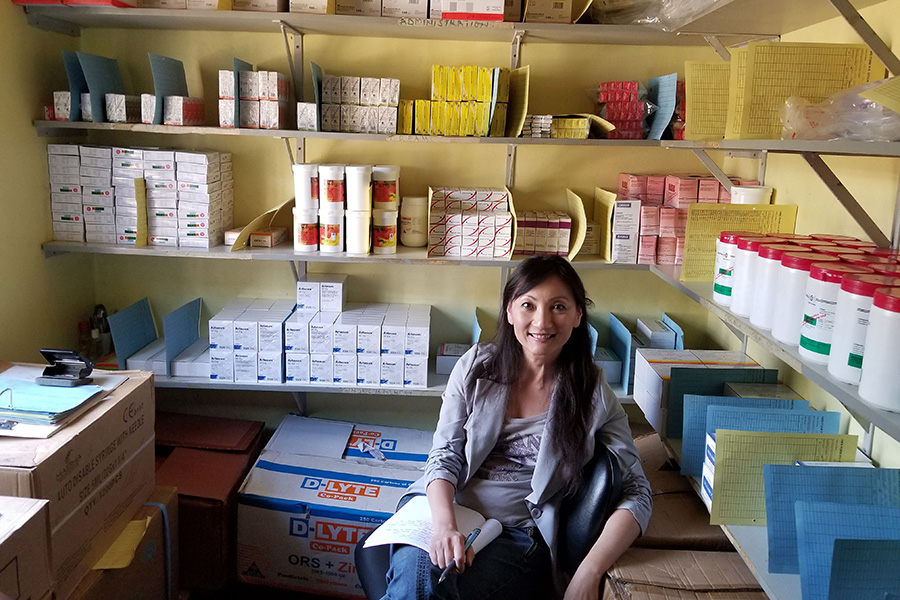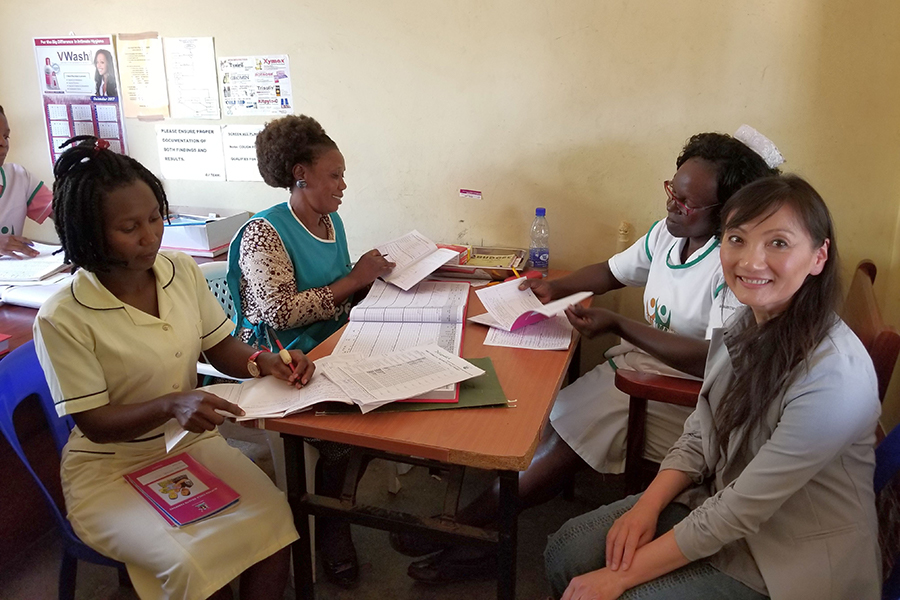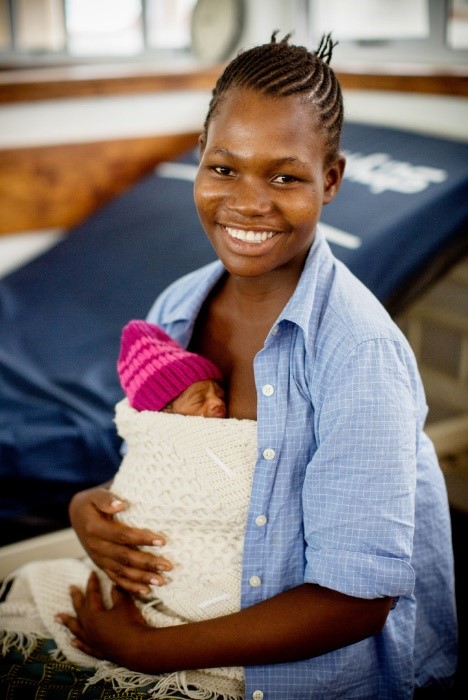Lab Projects Apply Engineering Lens To Solve Grand Challenges - Ultimately Saving Lives
Global Engineering’s Innovation for International Development (I2D) Lab offers the technical expertise and ingenuity needed to create and implement solutions to critical global problems that developing countries lack the resources or knowledge to solve themselves.
“We’re taking the principles I teach in class and applying them in the real world,” says Yuehwern Yih, PhD, Regenstrief Center for Healthcare Engineering Faculty Scholar, Director of the Smart Systems and Operations Laboratory, and Professor of Industrial Engineering. “What we do is high-risk but also high-reward.”
Yih is principal investigator for three I2D Lab projects, which together span infant and maternal health and emergency humanitarian response.
“All three projects are very important, in terms of their impact on the world and how Purdue engineers are engaging with partners to address global grand challenges,” says I2D Lab Program Manager Andrea Burniske.

Redesigning Space and Furniture To Save Infant Lives
Probably most innovative is a venture started in January to expand the use of Kangaroo Mother Care — a proven approach to saving the lives of late-preterm infants — in developing countries. “To our knowledge, this is the first time an engineering lens has been applied to promoting kangaroo care,” Burniske says.
Kangaroo Mother Care (KMC), named for a kangaroo’s pouch, employs continuous skin-to-skin contact between mother and baby and exclusive breastfeeding to help preemies receive necessary warmth and nutrition, bond with their mothers, gain weight, and improve their development. This simple, low-cost technique has been found to decrease neonatal deaths among low-birth-weight babies by 36 percent, and it is estimated it could prevent as many as half a million newborn fatalities each year.
However, Yih explains, “Health facilities in developing countries are not built and equipped to deliver family-centered care for preterm infants.”
Why? These countries’ health systems tend to focus on the healthcare provider and technology rather than the mother and family. The leading bottlenecks are a lack of smartly used space, a shortage of appropriately-competent health workers, and a lack of community mobilization.
The I2D Lab solution: design an optimal layout and inexpensive, space-saving furniture to enable hospitals in low-income countries to integrate KMC into their newborn care units. Among research steps, Yih and Steve Visser, a Professor of Industrial Design, have visited a pilot site in Malawi to meet with nurses, take room measurements, and observe current space use.
They’re collaborating with representatives of Save the Children, the project partner, and with a local development team, including area families, to understand space considerations and cultural context. The project complements Save the Children’s Saving Newborn Lives initiative, supported by the Bill & Melinda Gates Foundation.
After pilot testing, other sites in Malawi will be added. The I2D Lab team will be training physicians, nurses and mothers to make the most of the enhancements.
“The medical staff is very excited to have us come in and take an engineering approach,” Yih says. “They’ve very engaged with the project and fun to work with. It’s amazing what these physicians can do with limited resources.”
She adds: “Global health is an important subject, and equity is the issue. I’m proud to be making a small contribution to improving the quality of healthcare for all mothers and children, reducing the disparity.”

Sensing Demand To Prevent Maternal and Infant Deaths
Keeping new mothers and infants alive is the focus of another Yih-led project — one of two tapping Purdue experts’ supply chain management experience. Funded by the Gates Foundation in November, the project involves applying systems engineering principles and cloud-based smart sync technology to create a platform to sense and digitally track demand for medical supplies for maternal and newborn health in Uganda.
“Ninety-nine percent of maternal deaths occur in developing countries, and most relate to childbirth, which is the Number One killer for girls 15 to 19 years old,” Yih points out.
In Uganda and many other countries, coordinating supply and demand is difficult for healthcare providers because their paper-based reporting and requisition systems don’t provide information for timely decision making. As a result, the supply chain is managed poorly, with one hospital experiencing shortages while another is overstocked.
“The impact of mismatched supply and demand is devastating when budgets are constrained, which is when you have to manage inventory very carefully,” Yih says.
The new system will combine and cross-verify patient data in registers, diagnostic information in laboratories, and consumption data on stock cards to forecast demand and optimize ordering practices in primary care facilities.
“Digitizing this information will greatly simplify data capture and management, improve operational efficiency, and stabilize the supply chain,” Yih says. “This means, for example, that pregnant women will be assured of getting prenatal tests and essential medications will be available in the delivery room.”
The project team has selected a pilot site and is gathering information to build a predictive model. Joining Yih from Purdue are Md Munirul Haque, PhD., a Research Scientist at the Regenstrief Center, and Seokcheon Lee, an Associate Professor of Industrial Engineering. They are working with colleagues from the Gates Foundation, ResilientAfrica Network (RAN) Lab in Uganda, and Management Sciences for Health.

Delivering Emergency Relief Materials Efficiently
Better supply chain management also is at the heart of an I2D Lab project to streamline humanitarian aid distribution.
A team headed by Yih has been working for two years to develop and deploy a multi-platform, centralized, electronic emergency response system to replace paper-based systems.
Project requirements have changed three times, due partly to developments involving refugee populations. Yih and Dawei Wang, a Research Assistant in Industrial Engineering, have been collaborating with Catholic Relief Services teams responding to disasters in locations from Nepal to Haiti. Currently, Wang, who wrote the program, is field-testing a prototype to enhance hurricane recovery.
“Efficient delivery of emergency relief materials underpins the effectiveness of initial humanitarian responses,” Yih says. “In addition, a sustainable supply chain system ensures the progress of reconstruction of devastated areas and the safety of refuges. With paper-based systems, delays and shortages may occur any time, sabotaging a relief plan and endangering refugees.”
The centralized system, accessible with limited or no internet service, will dramatically simplify and improve emergency recovery. “All the information that response teams need will be available when they need it, enabling immediate decisions,” Yih says. “Tracing every step from purchase to delivery, the system will provide automatic inventory management and full accountability for reports to donors. Time and money saved will mean faster response and more money to help people.”
Yih anticipates broader application. “Catholic Relief Services is very excited about the project, and another organization is interested,” she says. “My dream is to eventually have multiple NGOs (nongovernmental organizations) collaborating on the system.”
Enthusiasm for I2D Lab
“I enjoy all the Global Engineering projects I’m involved in and find them all rewarding,” Yih says. “None of them could happen without the I2D Lab and Andrea Burniske, who uses her tremendous knowledge of the NGO space to match our capabilities with needs and secure funding. I’m a real fan and proud to be engaged with this group.”
